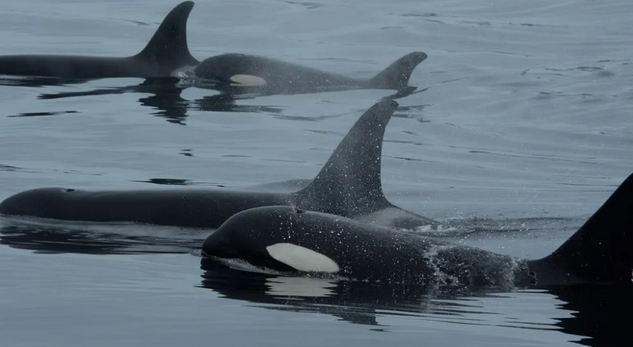— by Tom Owens —
Last month, I wrote an opinion piece in OrcasIssues that tried to describe the impact (CO2 production) of new electric loads (including EV’s) here in the San Juans. To understand this, we must know what type of fuel is used by the plant meeting the new load. The key to my view is that electric generating plants are dispatched (brought on and off line) on the economics of their variable cost (mostly fuel cost). This is electric industry standard practice. At any given time, the low cost plants are being used to their maximum capacity. Any new demand (EV or other) would be served by the next most expensive plant that was not operating at full capacity.
The clean generators (hydro, solar, wind, nuclear) all have very low variable cost. The dirty generators (natural gas and coal) all have higher variable cost. In my view, most of the time in the current NW Power Pool mix of generating plants, the plant that meets the new load would be a coal fired generator. If total load is low, this power could come from natural gas fired plants. Natural gas is displacing coal fired generation in the US, partly because of the lower cost of natural gas (thanks in part to fracking). This could change in the future, but for now, natural gas is generally cheaper than coal in our region.
The question this conclusion raised was “Compared to a vehicle running on gasoline, how clean (from a CO2 point of view only) is the new LEAF electric vehicle running on OPALCO electricity?”
I asked OPALCO for their calculations on this comparison; which they willingly provided and were kind enough to discuss with me. The “economic dispatch” concept took a beating but they listened. Their calculations and conversion factors lead OPALCO to the conclusion that a new LEAF is 200x, 40x, 5x or 3x as clean as gasoline vehicles (on E10 fuel) that get varying mpg. Their range of answers seemed to be based on which mix of generating capacity that they feel the electric energy would come from to charge the electric car. For example, the 200x result seems to compare a 10 mpg truck against a new LEAF running on a BPA mostly hydro mix of generation. These numbers would be correct if you identify the vehicles you are comparing, ignored the fact that the electric system is interconnected and if the concept of “economic dispatch” is incorrect. I would recommend comparing same size vehicles and using the resources that would be economically dispatched to meet the new load from our interconnected system.
So using OPALCO’s conversion factors and some US Energy Information Agency (EIA) data we can get some good but not perfect answers (good enough for ball park answers) to our question. For example, I have not tried to track down the CO2 cost of finding, transporting, refining and delivering the fossil fuels (gasoline, coal or natural gas) that are involved here or looked at the transmission and distribution system loses on the electric side. I use the “economic dispatch” concept to determine which generation resource the LEAF’s energy is coming from.
First let’s looks at a gasoline vehicle (using 10% ethanol fuel) going 1000 miles and getting 35 mpg (city):
CO2 production – 18.95 lbs. CO2/gallon – EIA including ethanol
28.6 gallons of gasoline consumed going 1000 miles at 35 mpg
CO2 produced —– 541 lbs. CO2
A new LEAF traveling 1000 miles using OPALCO energy from the incrementally dispatch plant:
4 miles/kwh – OPALCO’s number – this could be lower or higher.
Coal generation CO2 production – 2202.2 lbs. CO2/ Mwh – OPALCO
Nat Gas generation CO2 production – 981 lbs. CO2/Mwh – OPALCO
NWPP Blended CO2 production – 1132 lbs. CO2/Mwh – OPALCO
CO2 produced:
Coal ————- 550 lbs. CO2
Natural Gas —- 245 lbs. CO2
NWPP Blend —– 283 lbs. CO2
If you buy the “economic dispatch” approach, you could conclude from this that a gasoline vehicle at 35mpg traveling 1000 miles will emit about the same amount of CO2 as the LEAF traveling 1000 miles running on electric energy generated by coal (541 lbs. vs 550 lbs.). If the gasoline powered vehicle gets better than 35 mpg, it is cleaner that the LEAF. If the gasoline powered vehicle gets less than 35 mpg, the LEAF is cleaner. So the LEAF wins (from a CO2 emissions point of view) against lower mpg vehicles and loses against higher mpg vehicles (think Prius), 35 mpg being the break-even point.
If the LEAF was using electricity generated by combined cycle natural gas plants, it is about twice as clean as the 35 mpg gasoline car (541 lbs. vs 245 lbs.). So here, the LEAF wins, getting even better as the mpg of the compared gasoline vehicle goes down. Unfortunately, natural gas generated electricity is less expensive than coal generated electricity. The natural gas plants would likely already be on line. This would force the coal plants to take the new load. However, it could happen, at times, that the natural gas plant is used for the new load. In that circumstance this comparison is valid for the times natural gas is the fuel used to generate the electricity.
Some would take the view that the new LEAF is not really responsible for all the additional CO2 emitted to charge up the battery. The reasoning being that everyone already on the system has put the new load (the LEAF) onto the highest demand plant (coal) so everyone all should share in the additional CO2 produced. This would lead us to use a blended (from a power generation point of view) to calculate the LEAF’s share of the load. A good approximation of this blend (since I could not find WECC data) would be the North West Power Pool (NWPP) blend. Using a BPA blend (mostly hydro) is invalid because the BPA system is not isolated from the other systems in the WECC.
If you believe in the NWPP blended approach then the LEAF would be using coal, natural gas, hydro, solar, wind and oil plants in the NWPP. It would be cleaner than the 35 mpg gasoline car (541 lbs. vs 283 lbs.). Here the LEAF wins but it is not pollution free and not as good as a LEAF on natural gas generated electricity. However, it is important to realize that new CO2 production would actually be 550 lbs. So, someone has to stand up and take credit for the remaining 267 lbs. (550 – 283). This is simply a “who gets the blame” game. The atmosphere gets the whole 550 lbs.
So, pick your approach. At least you can see that there is a negative environmental impact for each use of electric energy, including Electric Vehicles. If the LEAF impact is less that the gasoline power vehicle, the net impact is positive. If the LEAF impact is greater than the gasoline power vehicle, the net impact is negative.
The good news is that the impact of conserving or producing a bit of energy with solar cells has the same quantitative CO2 impact but in the opposite direction. Here we are not involving a LEAF, just conserving or producing clean energy. It is positive for the environment.
This all raises yet more questions, “What are the other benefits of buying an electric vehicle?” “How does OPALCO (and all of us as owners) benefit if you buy an “EV?” Next time….
**If you are reading theOrcasonian for free, thank your fellow islanders. If you would like to support theOrcasonian CLICK HERE to set your modestly-priced, voluntary subscription. Otherwise, no worries; we’re happy to share with you.**








I have always wondered about this and appreciate you taking the time to try to answer such a complex question. Thank you.
Why do you have to assume that the new load (EV cars) is fulfilled by non clean energy (solar, wind, hydro, nuclear)?
What if the assumption went the other way? Well, then that would mean that a LEAF in this area produced 0 CO2, and all the other things we used electricity for were the things polluting. Oh, and the gas powered cars are still polluting no matter what.
My belief is that we need some serious regulations to make non clean energy REALLY expensive (and match the actual costs to the environment), and so the investment in new capacity will be clean energy sources.
The only way we are going to make any progress on global warming is to individually change our behaviors, and for me that means driving an electric car, installing solar panels on my roof, and hope that someone else is working on shutting down that coal plant and replacing it with something cleaner.
Thank you so very much for taking the time to really research and discuss the topic … without apparently having a real “agenda”. You have provided some excellent information.
An obvious policy response to your calculations is to keep retiring coal plants in favor of natural gas and renewable energy sources. Fortunately, this has been happening (as you mentioned), and at an accelerating rate.
Converting to all renewable energy sources would be a wonderful goal. We have a barn with a south facing roof which would be wonderful to cover with solar cells. It would also be wonderful to have a nice shiny new EV car. But for us, and I’m sure lots of other people, the economic realities preclude taking such actions. Island Market wants money in exchange for their food, the insurance companies wants to get their share, and I’m certain that the purveyors of solars plants and new EV cars would also want money in exchange for their goods. For lots of people their just isn’t enough money to go around no matter what their inclination is towards renewable energy.
Converting to all renewable energy sources would be a wonderful goal. We have a barn with a south facing roof which would be wonderful to cover with solar cells. It would also be wonderful to have a nice shiny new EV car. But for us, and I’m sure lots of other people, the economic realities preclude taking such actions. Island Market wants money in exchange for their food, the insurance companies wants to get their share, and I’m certain that the purveyors of solars plants and new EV cars would also want money in exchange for their goods. For lots of people their just isn’t enough money to go around no matter what their inclination is towards renewable energy.
Great presentation of the facts. I wonder whether you have access to information concerning the relative burdens on the environment of manufacturing and disposing of EV vs. gasoline-powered autos?
I have seen various calculations on this. The energy cost (CO2 load) of producing the coal or gasoline and delivering the power to the vehicle needs to be factored in. The off peak, interrupt-able charging of EVs can make efficient use of local generation as well. A long term advantage of EVs is that electricity can come from many sources so we can make it from what we have. What we can and what we do of course ane not necessarily the same.
Thank you for the interesting and useful information you’ve presented, and for helping us all make better-informed choices.
Using an electric vehicle seems a good choice, generally speaking, with the three exceptions of range, recharge time, and true dollar cost.
Here on Orcas, range is less of an issue. But long-distance travel still remains a little out of reach.
Because of the long recharge time presently required, long-distance travel is also rather inconvenient. (Musk’s scheme of quick recharge requires one to buy a prohibitively expensive car.) But local-errand travel certainly is feasible.
The extra cost of electric vehicles is presently partly offset by tax credits and the like, although the battery-pack replacement that all electric car owners face in the near future will be a big expense.
I look forward to convenient electric-powered transportation based upon continuous-recharge input built into major traffic arteries, plus battery power for local roadways.
I just don’t think that I’ll live long enough to see it.
Steve,
Sue and I have been driving our Leaf for about 2.5 years. We love it. The perfect island car – quiet, responsive, and very low maintenance. Range is about 100 miles, and we typically drive about 50 to 60 miles per day. Easy too to drive to Burlington and such. When we get home, we just plug it in to a regular 120 volt outlet on our garden shed.
We replaced a 18 MPG vehicle with the Leaf, and went from spending about $1,800 per year in gasoline to about $190 in electric. Quite a savings.
After all the tax credits, OPALCO discount, rebates and such, a new Leaf costs about $18.5k. Used ones seem to be selling for about $11k.
We are having such a good experience, we figure we will always have an EV.
A big part of the picture is missing. CO2 produced from the transport of crude, production of gasoline and then the transport of gasoline to the gas station should also be factored into this assessment. Maybe the electricity needed to run the plants and stations should also be considered.
Additionally, 35 MPG city is a high figure to be using. Very few non-hybrid cars achieve this. In fact, according to the University of Michigan Transportation Research Institute, the average fuel economy for a new vehicle purchased in May of this year was 25.5 MPG.
Thanks for spending time putting this together and sharing your research…most interesting.
I hope you do write the ‘next’ article, as the questions you leave us with are perhaps even more interesting to consider. The role of earlier adopter EVs vis-a-vis energy transition, the built environment and consumer behaviors is certainly important…and a most interesting area of debate.
Jay, I notice that Sue still drives a gas-guzzling SUV around town. Why is that?
I still drive a gas-guzzling SUV because there are occasions here when I need four-wheel-drive and relatively high underbody clearance. There are no all-electric cars which offer those features.
(I admit: I try not to drive it unless it’s necessary.)
We occasionally need to go to Bellingham for medical attention. No plug-in that we can afford is able to make that trip without an overnight stay in Bellingham.
That’s why Jean still drives an old, pretty efficient, gasoline-powered car.
Sorry: Electric transportation is still not a really good technology for everyone. It needs to go through a lot of maturing first.
Let me know when Sue trades her SUV for a plug-in.
Steve, You should see Sue driving both. Whoever goes out first or will drive the most on a given day takes the EV, and if possible and our schedules align mostly we drive together. If no alignment, then the CRV is used (26 MPG, US average MPG across all cars). We replaced our gas guzzler truck first. So by mostly driving the EV, we put just under 10,000 on it a year. We now put under 2,000 on the CRV.
For anyone with two cars, one ought to be an EV. It will be enjoyed and driven the most and the second car is good for longer special trips, or conflicting schedules.
The 100+ mile range of our EV gets us to Bellingham with 25% to spare, and their are chargers all over Bellingham. The car shows you locations on the map, and the Nissan Dealer has free very high speed chargers. You could plug in to a charger, have lunch, do some errands, and be topped off for the return trip in a few hours on 220 volt chargers, or 30 minutes on the high speed chargers. Let’s get together for lunch, and once I understand your particular driving needs, I might be able to suggest some solutions. Also, the Leaf has a forthcoming 200 mile range version coming out in 2016. For high underbody clearance, check out the BMW i3 EV. I believe it has adjustable shocks that raise and lower the car as needed.